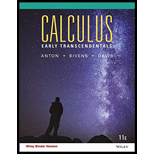
(a) Derive the analogs of Formulas (12) and (13) for surfaces of the form
(b) Let
Want to see the full answer?
Check out a sample textbook solution
Chapter 15 Solutions
CALCULUS EARLY TRANSCENDENTALS W/ WILE
Additional Math Textbook Solutions
Calculus: Early Transcendentals (2nd Edition)
Precalculus (10th Edition)
Calculus: Early Transcendentals (3rd Edition)
Calculus, Single Variable: Early Transcendentals (3rd Edition)
Precalculus Enhanced with Graphing Utilities (7th Edition)
Precalculus: Mathematics for Calculus (Standalone Book)
- Suppose F(x, y) = x² + y² and C is the line segment from point A = (1, −1) to B = (3, −5). (a) Find a vector parametric equation (t) for the line segment C so that points A and B correspond to t= 0 and t = 1, respectively. F(t) = = (b) Using the parametrization in part (a), the line integral of along C' is dt LE · dF = [ ° F (F(t)) - 7"' (t) dt = √° with limits of integration a = and b = (c) Evaluate the line integral in part (b).arrow_forwardThe equation of the tangent plane to the surface 32 = x² + y² +1 at (-1,1,2) is O A.-2x-2y+3z = 2 O B. 2x-2y+3z = 2 OC.x-y+3z = 2 OD. 2x-2y3z = 2 OE-x+2y+3z = 2arrow_forwardConsider a surface defined by F(x, Y, z) = 0 whose gradient is (cos(r2), z² e", 2ze"). The equation of the tangent plane to the surface at the point (-2,0, 1) is O x + y+ 2z -1 = 0 x - y – 2z + 4 = 0 x – z + 3 = 0 O x + y + 2z = 0arrow_forward
- Consider the function f(x,y,z) = x e yz. (a) Find Vf = |i+j+ k (Type an exact answer, using radicals as needed.) (b) Determine the tangent plane at (2, 0, 2) for the level surface f(x, y, z) = 2. (Express your answer in the form a (x- Xo) +b (y- Yo) +c(z-zo) = 0, where a,b,c,xo.Yo Zo are constants you have to determine.)arrow_forwardLet F = -9zi+ (xe#z– 2xe**)}+ 12 k. Find f, F·dĀ, and let S be the portion of the plane 2x + 3z = 6 that lies in the first octant such that 0 < y< 4 (see figure to the right), oriented upward. Z Explain why the formula F · A cannot be used to find the flux of F through the surface S. Please be specific and use a complete sentence.arrow_forward2. Find an equation of the tangent plane to the parametric surface F(u, v) = (, 2uv, uv?) at the point (-2, -4, –4).arrow_forward
- Let L, be the line given by the intersection of two planes 2x- y+z = 1 and x – y = -2 and let L2 be the line given by parametric equation x = 2 – t L2 : y = 3 – 5t z = t If u denotes the direction vector of L1 and uz denotes the direction vector of L2. Then (a) Find the vectors u and uz. (b) Find the dot product of the vectors u and u2. (c) Find the cross product of the vectors u and u2.arrow_forwardSuppose F(r, y) -yi + xj and C is the line segment from point P = (2,0) to Q = (0, 5). (a) Find a vector parametric equation 7(t) for the line segment C so that points P and Q correspond to t = 0 and t = 1, respectively. r(t) = (b) Using the parametrization in part (a), the line integral of F along C is F. dr = | F(F(t)) · F"(t) dt = dt with limits of integration a = and b (C) Evaluate the line integral in part (b). (d) What is the line integral of F around the clockwise-oriented triangle with corners at the origin, P, and Q? Hint: Sketch the vector field and the triangle.arrow_forward- Parametrize the intersection of the surfaces y² = z² = x − 1, y² + z² are needed). (Use symbolic notation and fractions where needed.) x(t): = y(t) = = z(t) = ± = 25 using t = y as the parameter (two vector functionsarrow_forward
 Calculus: Early TranscendentalsCalculusISBN:9781285741550Author:James StewartPublisher:Cengage Learning
Calculus: Early TranscendentalsCalculusISBN:9781285741550Author:James StewartPublisher:Cengage Learning Thomas' Calculus (14th Edition)CalculusISBN:9780134438986Author:Joel R. Hass, Christopher E. Heil, Maurice D. WeirPublisher:PEARSON
Thomas' Calculus (14th Edition)CalculusISBN:9780134438986Author:Joel R. Hass, Christopher E. Heil, Maurice D. WeirPublisher:PEARSON Calculus: Early Transcendentals (3rd Edition)CalculusISBN:9780134763644Author:William L. Briggs, Lyle Cochran, Bernard Gillett, Eric SchulzPublisher:PEARSON
Calculus: Early Transcendentals (3rd Edition)CalculusISBN:9780134763644Author:William L. Briggs, Lyle Cochran, Bernard Gillett, Eric SchulzPublisher:PEARSON Calculus: Early TranscendentalsCalculusISBN:9781319050740Author:Jon Rogawski, Colin Adams, Robert FranzosaPublisher:W. H. Freeman
Calculus: Early TranscendentalsCalculusISBN:9781319050740Author:Jon Rogawski, Colin Adams, Robert FranzosaPublisher:W. H. Freeman
 Calculus: Early Transcendental FunctionsCalculusISBN:9781337552516Author:Ron Larson, Bruce H. EdwardsPublisher:Cengage Learning
Calculus: Early Transcendental FunctionsCalculusISBN:9781337552516Author:Ron Larson, Bruce H. EdwardsPublisher:Cengage Learning





